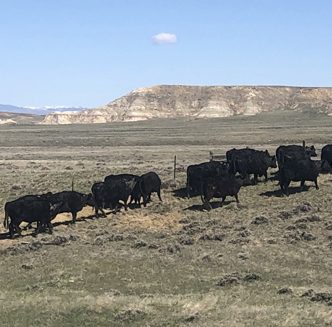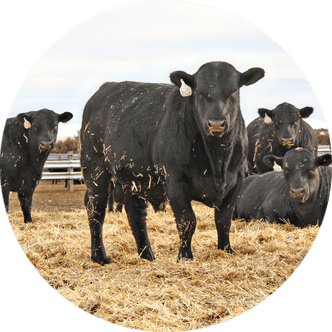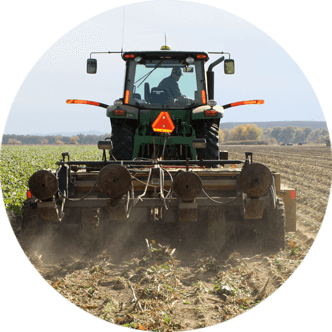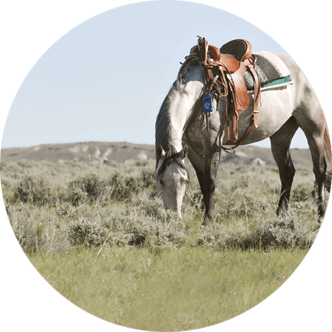First-Calf Heifers: The Post-Calving NutritionMistake Producers Can’t Afford to Make
by Dagan Montgomery
Heifers are the future of the cow herd. These young females represent genetic progress, years of investment and the foundation of the herd’s long-term productivity.
But as most ranchers know, despite their potential, they’re also the most demanding to manage.
During and after their first pregnancy, proper nutritional management is critical to ensure heifers recover in time to be rebred and remain productive members of the herd.
After delivering their first calf, heifers face a unique set of challenges.
The post-calving period is the most nutritionally demanding time in a beef cow’s production cycle and even more so for a first-calf heifer.
They’re both nursing a calf, which demands large amounts of energy, as well as recovering from calving, which at this point is the most stressful event they’ve likely yet experienced.
It is important to remember they are also still growing themselves and must prepare for rebreeding – all while competing with mature cows for resources if run in the same herd.
Because energy is prioritized by the body for basic maintenance first, followed by lactation, growth and finally reproduction, any shortfall in energy intake can delay or prevent a return to heat.
If their nutritional needs aren’t met during this critical window, their likelihood of successfully being rebred over the summer will be diminished, and consequences can ripple through the herd’s reproductive success and bottom line for years.
Heifers versus mature cows
On a total pounds of energy and protein basis, heifers’ requirements are similar at the same stage of lactation as a mature cow, but the difference lies in intake capacity.
Simply put, mature cows can eat more. They have larger rumens and better feed efficiency, which gives them an edge when forage quality is marginal.
First-calf heifers, on the other hand, have limited intake, especially around the time of calving.
Research from the University of Nebraska shows intake drops by about 17 percent in the three weeks leading up to calving, only rebounding to more normal levels roughly a week after calving. This means the diet needs to be more nutrient-dense to meet their energy and protein needs in a smaller volume of feed.
In other words, the overall percentage of the diet made up of protein and energy needs to be higher for first-calf heifers than with mature cows.
This is why it is a good idea to separate heifers from mature cows leading up to calving and, if possible, to manage them on a more nutrient-dense feed regimen to avoid underfeeding heifers or overfeeding mature cows.
Assessing body condition to monitor nutrition
Keeping first-calf heifers in adequate body condition is critical. Ideally, they should calve in a body condition score (BCS) of five or six and maintain this through the breeding season.
Lower BCS animals will have a longer postpartum interval (PPI) – the time between calving and coming back into heat. The longer her PPI, the less chance she will be bred by the desired timeframe.
If she is to continue calving year to year, she needs to be rebred within a 60- to 85-day window.
Unfortunately, many producers see heifers lose weight and fall below this BCS threshold between calving and breeding, reducing their chances of conceiving early and pushing them into a late calving cycle or out of the herd altogether.
A common misconception is a first-calf heifer at a lower BCS – below five – will lead to a lower birthweight calf and, therefore, fewer calving difficulties. This is not true. Birth weight is influenced more by genetics than BCS and will only decrease slightly if a heifer is kept underweight.
Not only can a low BCS worsen calving difficulty and weaken the heifer, it can also jeopardize her ability to breed back.
For a better look at how to monitor BCS, refer to the University of Wyoming Extension’s “Three-Step Body Condition Scoring Guide for Range Cattle: Implications for Grazing and Reproduction,” found at wyoextension.org/publications.
Supplementing a higher nutritional demand
Providing high-quality forage is important, but forage alone often won’t meet minimum nutritional needs, especially in late winter or early spring calving Wyoming herds.
For instance, hay with 58 percent total digestible nutrients (TDN) and 11 percent crude protein (CP) might look decent on paper due to the relatively high CP, but it falls short of the 62 percent TDN required to support lactation and reproduction in first-calf heifers.
This is why strategic supplementation is critical on Wyoming ranches, where harsh winters and late springs often prevent sufficient forage production from lining up with calving.
Energy and protein-dense feeds such as distillers’ grains, gluten feed, 20 percent protein cubes or alfalfa hay can be used to bridge the gap.
Depending on hay quality and supplement type, it may take two to three pounds per head per day of additional energy and protein to meet requirements. Feeding loose byproduct supplements can be a challenge in a pasture setting, but studies show supplement processed into cubes or cake shows little wastage.
Alfalfa is a very common supplemental feed in Wyoming and can be a sufficient source of protein and energy when fed with grass hay or pasture. However, it is important to note alfalfa can still fall below requirements for both TDN and CP.
Therefore, it is critical to test each lot of alfalfa hay for nutritive value before relying on it to fill in for what grass hay lacks.
For more information on testing hay, refer to “Hay Testing for Cattle: Understanding the Results,” available at wyoextension.org/publications.
It is also worth noting much of the CP in alfalfa hay is made up of rumen degradable protein, rather than rumen undegradable protein (RUP), as is found in higher quantities in byproduct feeds.
RUP is more efficiently converted to muscle and structural growth and, therefore, feeds like distillers’ grains or beet pulp may be more beneficial to the first-calf heifer.
Minerals, while often overlooked, are also key components of a balanced diet. With a solid base diet, a good mineral program is essential for reproductive performance and milk production.
For a growing heifer now producing milk for her calf, mineral supplementation can be critical, especially if forage is lacking.
The payoff is getting it right
First-calf heifers fed and managed correctly after calving are far more likely to rebreed on time while providing for the calf, stay on the right calving schedule and become long-term, productive members of the herd. Those that don’t get the nutrition they need are more likely to fall behind or drop out entirely.
Heifers require more labor and feed inputs than their mature counterparts, but when managed correctly, the investment pays off and heifers turn into dependable cows that will raise heavy calves and calve on schedule for years to come.
Understand the increased nutritional requirements of the heifer herd, monitor BCS throughout the production cycle immediately before and after calving and develop a supplement program to meet the heifer’s needs.
This will optimize their ability to get rebred and remain a productive part of the beef herd in years to come.
Dagan Montgomery is University of Wyoming Agriculture and Natural Resources Extension educator. He can be reached at dmontgo8@uwyo.edu.





